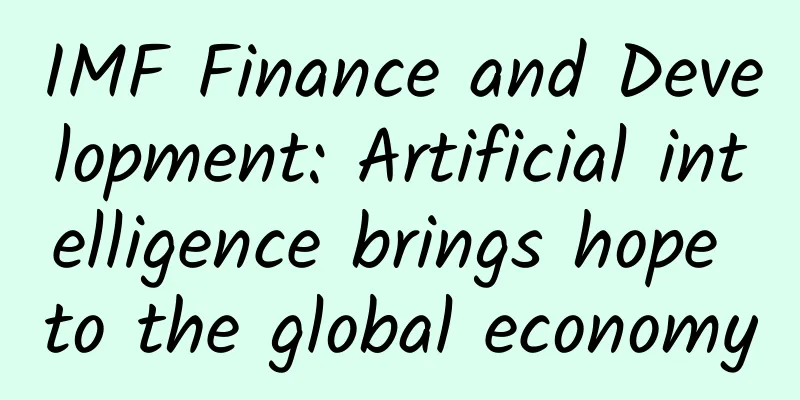IMF Finance and Development: Artificial intelligence brings hope to the global economy

|
If used properly, AI could significantly accelerate economic growth and help achieve a rebound in productivity growth. The post-pandemic global economy is plagued by many factors: slower growth, the most persistent inflation in decades, limited progress on sustainability, and high borrowing costs that have weighed on investment (including the massive investment needed for the energy transition). Perhaps the biggest headwind, however, is the weakness in productivity growth since the global financial crisis. Artificial intelligence (AI) is our best chance to address supply-side constraints that have led to slower growth, new inflationary pressures, higher capital costs, fiscal distress and shrinking fiscal space, and challenges in achieving the Sustainable Development Goals. This is because AI has the potential not only to reverse the trend of declining productivity, but also to bring about sustained and substantial productivity gains. Of course, this will take time. Roy Amara’s law applies here as much as it did to past technological transitions: we always overestimate the short-term impact (of a technology) and underestimate its long-term impact. My best guess (and it’s just a guess, based on current investment patterns) is that we may start to see a profound impact of AI on labor productivity by the end of this decade. All of this is the result of the collision of three powerful forces. The first is shocks, including pandemics, climate change, geopolitical tensions, resurgent nationalism, and a growing focus on national security issues in the conduct of international economic policy. These increasing severity and frequency of disruptions are pushing global supply networks toward greater diversity and resilience. But this is a costly strain and one that is also a recipe for inflationary pressures. For example, Apple is increasing its manufacturing shift to India, where 15% of iPhones are currently made, and only South Korea and Taiwan Province of China produce (but not design) the most advanced semiconductors, an arrangement that is unsustainable from a national security perspective. Policy moves aimed at repatriating key supply chains, or at least moving them to friendly countries, have increased diversity in resource access while making it harder for adversaries to obtain goods, technology and capital. Some of these protectionist policies are designed to protect domestic workers from foreign competition. The result is a rapid post-pandemic unraveling of global supply networks that were more interconnected after World War II. Supply chains have since largely followed the norms of economics: efficiency and comparative advantage. It is no longer possible to maximize resilience while minimizing costs—and we no longer do so. Among other factors, this structural shift has fueled inflationary pressures. Even as supply chain pressures caused by the coronavirus pandemic have eased, a second set of colliding forces has manifested itself in longer-term trends that have further reduced the economy’s supply resilience and pushed up costs. These trends include falling productivity, particularly in advanced economies. These trends also include aging populations in economies that account for more than 75% of global output. Falling fertility rates and longer lifespans are slowing growth in the labor force (or reducing it), resulting in fewer workers and more elderly people to care for. This creates fiscal pressures for social security systems when central bank interest rates remain high. Surprisingly, many advanced economies are experiencing labor shortages in their high-employment sectors. This is holding back growth and fueling inflationary pressures, particularly in the United States, amid strong aggregate demand. Germany is experiencing similar labor supply problems. The impact of the pandemic includes rising sovereign debt levels in many economies. Global sovereign debt now exceeds global GDP and continues to rise, with the US sovereign debt ratio now above the 120% threshold. The ratio for Europe is 88.6%, with above-average ratios in Greece, Italy, Spain, France, Belgium and Portugal (Greece and Italy by a wide margin). China’s sovereign debt level looks lower, but it excludes debt of state-owned enterprises, which are a significant part of the corporate sector. This can be explained in part by the massive spending during the pandemic, aimed at saving lives, preventing business failures and avoiding losses on personal and corporate balance sheets. One reason demand has remained resilient in the face of rising interest rates is precisely that the losses on balance sheets have been much smaller in the pandemic than in the global financial crisis. Finally, in the second set of forces, the powerful deflationary forces that have persisted for decades, associated with growth in emerging market economies and the massive expansion of capacity in the global economy (especially but not limited to China), are fading. Development economists call this the “Lewis turning point.” In this growth phase, the underemployed and underutilized labor in traditional sectors of emerging market economies is largely employed and absorbed by urbanized and more connected parts of the economy. Productivity deserves special attention. From 1998 to 2007, when many Americans gained access to the internet and, later, mobile phones, productivity growth averaged 1.68%. Then, from 2010 to 2019, productivity growth slowed to 0.38%. The decline is felt across the economy. Productivity growth in the tradable goods and services sectors, which tend to be more productive despite employing less than a quarter of workers, has also slowed, falling from 4.27% to 1.23%. Productivity growth in the large and less productive non-tradable services sector has fallen from 0.73% to effectively zero. A striking fact is that despite recent soft productivity growth, the United States has been outperforming other advanced economies, including across Europe. Europe’s lagging growth and productivity are due in part to slower and more efficient adoption and deployment of digital technologies, as well as a lagging technology sector relative to the United States and China. Productivity indicators in Europe have risen slightly during the pandemic, largely because of partial shutdowns in less productive sectors and a shift to remote work in more productive sectors. We need more data to know whether this rebound will last, but we have seen similar patterns in other advanced economies. The combination of these two sets of forces has caused the economy to move relatively quickly from demand-constrained to supply-constrained growth. Growth is weak. Inflation is persistent. Real interest rates remain high. Many economists, including me, believe that the structural environment I have described means that borrowing costs are likely to remain high, and certainly higher than in the decade after the global financial crisis. This is likely to bring about major changes in the investment community, including keeping capital costs and discount rates higher and depressing valuations. It is worth noting that investors are divided on the likely path of interest rates and can change their views. For example, expectations last year that the Fed would make seven 25 basis point rate cuts this year quickly collapsed. The market is now expecting one or two rate cuts from the Fed this year. Market expectations may further believe that interest rates will remain higher for longer, and the structural environment also points to this. That brings us to the third set of colliding forces: science and technology. There are at least three revolutions going on right now. The first is a decades-long digital transformation, now being accelerated by breakthroughs in AI. The second is a transformation in biomedicine and the life sciences. The third is the technologies underpinning the transition to sustainable energy. All three of these changes are supported by ample investment. The pace of progress is being driven not only by technological breakthroughs but also by a powerful array of tools that are falling in cost and increasing in availability. The cost of solar energy has fallen dramatically over the past decade. Other areas of technological progress have also occurred dramatically, from advanced semiconductors to DNA sequencing to the free availability of 3D models of hundreds of millions of proteins in public databases. The development of such technologies and their deployment for productive use would spur major structural changes in the world economy. We cannot predict the full scope of what these changes will portend, but their impact is sure to be enormous. Emerging technologies can continue to boost productivity, as I argued last year in a paper I co-authored with Google’s James Manyika on the potential of generative AI. This is consistent with estimates from, for example, the McKinsey Global Institute. Generative AI is the first AI with human-like capabilities, operating in multiple domains and able to detect and switch domains based on conversational instructions alone. It can discuss inflation, write computer code, and do some math—although it is still under further development. Its superhuman pattern recognition ability makes it a powerful digital assistant. A more ideal model than full automation is human-machine collaboration, which is sometimes called "augmentation." Geoffrey Hinton, a pioneer of modern neural network AI, has a unique understanding of the impact of AI. He uses the example of an experienced doctor. While this doctor may have treated thousands of patients, medical AI is able to review and absorb hundreds of thousands of patient records. In this way, medical AI is a great help for experienced doctors, but even more so for those with less experience. This is consistent with research findings on the use of AI in other areas, such as customer service, where AI digital assistants, trained by past interactions, have led to significant productivity gains overall and even greater benefits for less experienced staff. AI is a general purpose technology that has applications across the economy, both by sector and by job type. This is important because only general purpose technologies can lead to large economy-wide productivity gains. AI applications are already being built into personal devices like cell phones, thanks in part to advanced semiconductor technology. Still, there are challenges to overcome to realize AI’s greater potential. One of these challenges is implementing regulation to prevent misuse of technology and data. This regulatory agenda to reduce risk is underway around the world. Another challenge is overcoming automation bias, or what Erik Brynjolfsson calls the “Turing trap” — the strong tendency to automate completely and replace humans. This is a common view in the media, industry and policy discussions, and is reflected in widespread concerns about a sharp drop in employment. Perhaps the most important policy question concerns the potential gains. For AI to realize its full economic impact over time, it must be accessible to all sectors of the economy and to businesses large and small. While large investments in industries such as technology and finance will undoubtedly have a major impact, AI adoption will need to reach sectors with large employment, which tend to lag in adopting AI (such as government, health care, construction, and hospitality). Studies of digital technology adoption before the AI era suggest that such a pattern of widespread diffusion is not inevitable but is possible or even likely to depend entirely on the differentiation of market forces. Policies to support the availability, diffusion and skills of AI to help realize its full potential are weak compared to the intense focus on reducing risks and preventing misuse of AI technologies. Increasing the latter without abandoning the former is an important part of policy rebalancing. This is not to advocate that governments pick winners or national champions. Instead, effective competition policy should be part of a package of policies. In addition, the focus needs to be partly on sectors and companies that may lag in technology discovery and adoption, such as small and medium-sized enterprises. And, because jobs will change as AI applications emerge, reskilling and the acquisition of new skills should be a priority. The potential benefits of AI far outweigh the challenges of addressing post-pandemic productivity and growth. These benefits will impact research from biology to physics and materials science, and play a key role in the energy transition. Talent, computing power, and rapidly growing electricity demands are the main barriers to building increasingly powerful generative AI models. Data availability is not the main constraint. There is ample data available for training on the Internet. Of course, some AI does not fall into the category of powerful and important generative AI. One example is AlphaFold, an AI system that predicts the 3D structure of proteins. To apply this system, you need to invest in specialized biological data and expertise about how protein folding works. Likewise, the large platforms that drive generative AI do have business models that rely on personal data and highly precise targeting. However, the training of models such as large language models does not require sensitive personal data. These systems, powerful enough to train models with billions of parameters, exist primarily in private sector cloud computing systems, mostly in the United States and China. This, combined with competition for talent, puts the scientific and academic communities at a disadvantage. Expanding computing infrastructure to a broad community of researchers and innovators is an essential and important policy step. This will build an open community in a democratic way and keep it well balanced between academic and private innovation. Achieving this balance will support the broad diffusion of technology. Europe is likely to lag behind the United States and China in developing and applying AI for three reasons. First, the EU's funding for basic research is relatively insufficient. Second, the EU lags in computing power to support research. Third, it fails to fully exploit the large scale of the European economy. Because digital and AI technologies have high fixed development costs and relatively low variable costs, large-scale application is a huge advantage that determines the return on investment. European capital markets remain relatively fragmented; service market integration is not yet complete and is hindered by regulatory fragmentation at the national level. Whether this situation will continue or change after the recent European Parliament elections remains to be seen. Two reports submitted to the European Commission - one from Enrico Letta and the other from Mario Draghi - advocate increased investment in digital technologies. China is an AI powerhouse. India, with its strong roots in digital technology, a large and growing domestic market, and a deep reserve of engineering human capital, is likely to become a growing force. Other emerging market economies may benefit greatly from AI applications, but for at least the next few years they will primarily be consumers of advanced AI technologies, mostly produced in the United States and China. AI will drive massive structural change and disruption over the coming decades. While some groups will lose their jobs to automation or rapid productivity gains, and others will be hired to do new jobs created by AI technologies, the biggest impact will be on workers in the middle. In this middle position, jobs will not necessarily disappear, but they will change. This will be a disruptive process that requires different skills and a lot of organizational change. Both the private and public sectors will play an important role to ensure a smooth transition. If policies are put in place to help AI technologies spread more rapidly throughout the economy, AI could significantly accelerate economic growth and help productivity growth rebound. And if AI technologies relax supply-side constraints that are partly responsible for inflation, it could indirectly reduce real interest rates and capital costs over time. This will be helpful in a world where trillions of dollars of investment are needed to change the equation for energy efficiency and green transformation. In terms of the aging problem facing the global economy, AI will help the younger working population support the older ones without making excessive sacrifices. Despite shocks to growth and secular headwinds, we do have the talent and tools to boost global growth, inclusion, and sustainability—but only if we are willing to use them proactively and wisely. Author Michael Spence Senior Fellow at the Hoover Institution |
<<: Is The Division shrinking or disconnecting? A full experience of The Division on PS4
>>: How powerful is Google's Go program AlphaGo? 30,000 times more powerful than IBM's Deep Blue
Recommend
2020 Mid-level KOL Marketing Development Report
For brand owners, how to obtain effective traffic...
Tencent releases 2015 WeChat user data report
WeChat is no longer just a mobile application ful...
After working in operations for so many years, have you ever thought about the definition of operations?
A few days ago, a friend was chatting with me and...
Collection | 7 secrets to using "Toutiao" to attract traffic. It will be too late if you don't do it now!
There are many self-media platforms today, and al...
Unboxing the TD-LTE iPad Air
In terms of network support, the new 4G iPad suppo...
Why are domestic mobile phones so popular, but still cannot outsell Apple?
Domestic mobile phones are becoming more and more...
Guangzhou Hairstyle Design Mini Program Function, How Much Does It Cost to Make a Barber Shop WeChat Mini Program?
“The head can be cut off, but the hairstyle canno...
iOS componentization is not just the architect's job
iOS componentization was once a hot topic in the ...
Where have Apple fans gone? Will they come back?
Revenue contribution from Greater China fell to i...
Why are there so many bad domestic movies this year?
Discussing the quality of a film is a somewhat su...
The latest Baidu promotion and traffic diversion skills in 2021, you can learn them in minutes
We have always said that traffic is the core of I...
Why did Harry Potter kiss under the mistletoe?
Christmas is coming soon. If nothing unexpected h...
How to avoid “naked” marketing? 4 ways to teach you how to borrow endorsements
Naked marketing is a marketing method with no bra...
Several tips for Swift development
As the saying goes, the best way to master a tech...
Microsoft is working hard! Chrome extensions can be used directly in Edge browsers
Windows 10's new Edge browser has received a ...









